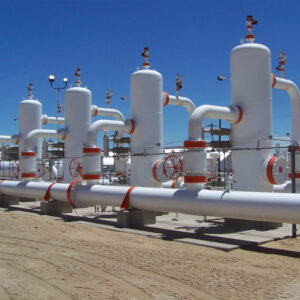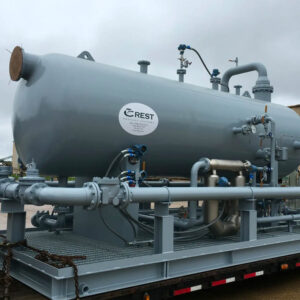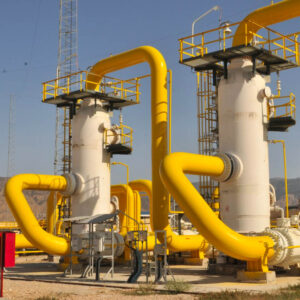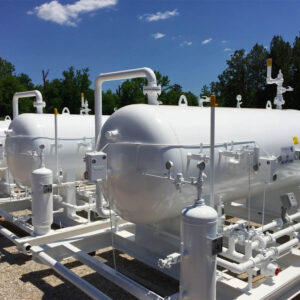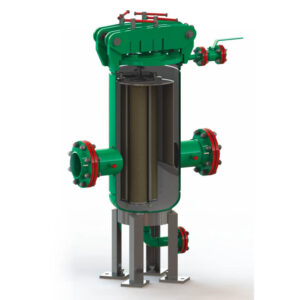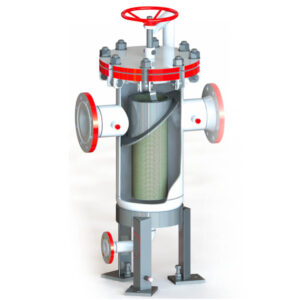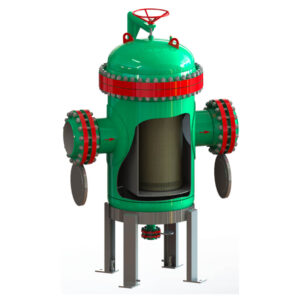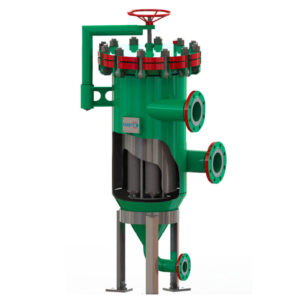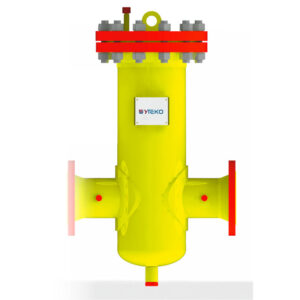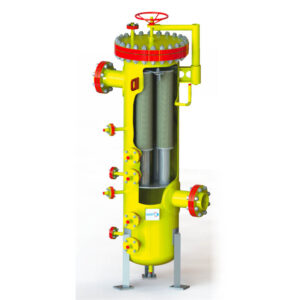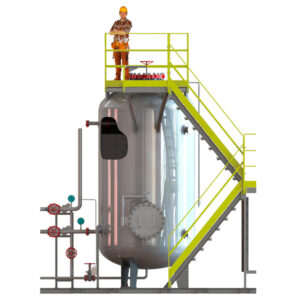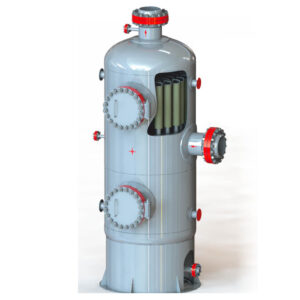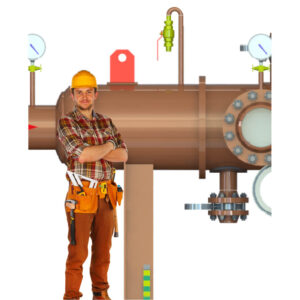Separation equipment
Gas separators (GS)
To purify natural and petroleum gas from mechanical impurities, liquid hydrocarbons, drops of moisture, suspended and other particles, equipment such as a gas separator is used. This device is an integral element of technological lines at natural gas production, treatment and storage facilities. It is used by oil and gas, chemical and processing industries.
Design and principle of operation of the gas separator
The GS gas separator can be used as a stand-alone unit or as one of the components of the whole complex.
Gas separators are usually classified according to their design features. According to this classification, gas separators can be horizontal or vertical. The main difference between these devices is the installation method.
Regardless of classification, gas separators consist of a horizontal or vertical shell with elliptical bottoms and internal devices. To install gas separators in the design position, claw supports or stand supports are used.
The design of gas separators also includes hatches, process and auxiliary fittings. Such design features are necessary to provide access to the inside of the device, for gas inlet/outlet, condensate drainage, installation of instrumentation, shut-off and safety valves and other equipment. Additionally, gas separators can be equipped with a liquid or steam heating system to maintain operating temperature.
The type of design and composition of the device depends on the following factors:
- amount of input gas;
- properties and composition of the inlet gas;
- requirements for output gas parameters.
One type of gas separator GS is a centrifugal gas separator. The operating principle of such a separator is based on the action of centrifugal force, under the influence of which the gas is purified from dropping liquid and mechanical impurities.
What to look for when choosing a gas separator?
When choosing gas separators, it is important to pay attention to the technical characteristics of these devices:
- volume;
- pressure;
- performance;
- degree of cleaning.
Vertical gas separator
The vertical gas separator consists of a cylindrical shell and is equipped with media inlet and outlet fittings, as well as instrumentation fittings. The gas separator can be equipped with thermal insulation, which, if necessary, will allow it to operate over a wide temperature range.
Gas separators are designed to purify natural gas and associated petroleum gas from dropping liquid (gas condensate, oil). Gas separators are widely used in oil and gas production enterprises, in the chemical industry, in the production, transportation and storage of gas mixtures.
According to the principle of operation, vertical separators can be divided into several types:
- gravitational, the operation of such separators is based on the difference in the density of the separated media; when the flow rate decreases, this difference allows a heavier medium to settle into the bottom part of the separator;
- inertial, in this type of separators, due to internal devices, the direction of the gas can be sharply changed, as a result of which the heavier liquid phase will hit the walls of the devices and flow down them into the bottom part of the separator;
- mesh, the delivery package of such separators includes a package of drop catching devices that do not allow the gas environment to carry away liquid;
- centrifugal, the separation of gas from the liquid medium in such separators occurs due to special internal devices that swirl the flow and phase separation occurs under the influence of centrifugal force;
- mixed type, such separators can combine the advantages and features of several types of gas separators.
Horizontal gas separator
Horizontal gas separators (horizontal gas separators) are designed to purify natural and associated petroleum gas from finely dispersed droplet liquid. High quality of gas purification, as well as ease of maintenance, ensure the widespread use of these devices in oil treatment plants, preliminary water discharge plants and in many mining and production enterprises.
The horizontal gas separator is a horizontal cylindrical apparatus mounted on saddle supports and equipped with process fittings for product inlet and outlet, fittings for installing instrumentation, as well as inlet and internal devices. Depending on the climatic conditions of use of the separator, thermal insulation of the device is possible.
Horizontal gas separators can provide high performance even with a large volume of liquid droplets, or with a high risk of gas slugging.
The advantage of a horizontal gas separator is that, due to its design, it is able to retain liquid in itself longer than other types of separators; accordingly, gas bubbles entrained by the liquid have time to float to the surface and join the main volume of gas, and the time for collecting the smallest droplets of liquid from gas flow, thus increasing the quality of sedum. The liquid accumulates in the bottom tank of the separator and is periodically removed from the tank by a special control valve, the operation of which is automatically regulated by a level gauge. In front of the gas outlet fitting, a droplet eliminator is installed in the separator, which catches, enlarges and precipitates the smallest drops of liquid so that they are not carried away with gas flows. The pressure in the tank is maintained automatically using a control valve installed on the gas outlet line from the separator; the operation of this valve is regulated by a pressure sensor, which is provided on the tank.
Centrifugal gas separators (GSC)
A centrifugal gas separator is a device used to purify gas from droplet aerosol liquid, as well as from suspended tiny solid contaminants due to centrifugal forces.
The centrifugal vertical gas separator is a vertically oriented, cylindrical shell equipped with the necessary fittings and internal devices. The principle of operation of vertical centrifugal separators is as follows: the gas-liquid mixture enters through an inlet pipe located tangentially, which allows the gas to impart a rotational movement inside the separator. The swirling of the flow is also supported by internal guide devices. Under the influence of centrifugal forces, the denser components of the mixture (liquids and mechanical impurities) are thrown from the center of the separator to its walls and lowered into the bottom part of the separator, from where they are periodically discharged through the liquid medium outlet pipe. Gas, cleared of inclusions, rises to the upper part of the separator, where it undergoes final purification from the smallest drops of liquid, passing through a drop separator, and is discharged through the gas outlet fitting. The pressure in the separator is maintained by a control valve installed on the gas outlet fitting, which is controlled by a signal from a pressure sensor installed on the separator.
The level of condensate in the bottom part is regulated by a valve located on the liquid outlet pipe; the valve is controlled by a signal coming from a level sensor installed on the separator.
Advantages of centrifugal gas separators
The advantages of this type of separators are the simplicity of design and maintenance, the separator does not have filters that require frequent replacement, is small in size and weight, and can be used in places with harsh climates. With all the advantages, the centrifugal separator provides separation quality of up to 99.9% over a wide range of loads with a pressure loss not exceeding 0.003 MPa.
If necessary, the centrifugal gas separator can be heat-treated, have an internal anti-corrosion coating and have devices for attaching thermal insulation. Separators are classified according to the internal diameter of the body and design pressure.
Flare separator (FS)
All oil and gas production enterprises, as well as companies involved in refining petroleum products, use FS flare separators, which are necessary for the primary purification of the transported medium from contaminants and drip moisture. Such installations are part of the gas treatment system, gas control points and distribution networks, ensuring the production of highly purified fuel.
Design features and purpose of flare separators
Any flare separator is a cylindrical container of horizontal design with an elliptical bottom and a special support, with the help of which it is fixed to the support platform. Such a device must include shut-off and safety and control and measuring devices (pressure gauges, valves, taps, thermometers), as well as fittings for the inlet/outlet of the working medium and manholes.
For a durable installation of the FS, special anchor bolts are used to secure the container to a reinforced concrete slab located in an open area or in a heated indoor space. In order to ensure reliable thermal insulation of the internal environment, in some cases flare separators are equipped with additional thermal insulation. The main task of a flare separator is to effectively clean the gaseous medium from dropping liquid, plugs and third-party mechanical impurities.
The principle of operation of the FS and system options
Regardless of the design, any FS flare separator has vertical and corner mesh nozzles inside. When a gas-liquid mixture passes through them under pressure, it is evenly distributed. This causes the process of partial separation of the drip liquid, which flows through a special fitting located in the lower part of the container.
If we talk about classification, then FS flare separators of block design are divided into vertical, horizontal and hydrocyclone, which differ in their design. When choosing a suitable separator modification, take into account the following:
- Volume of a cylindrical container;
- Climatic version;
- Availability of additional heat treatment;
- Design pressure;
- Presence of anti-corrosion coating.
Cartridge filters for cleaning liquid media
Cartridge filters are designed for fine purification from mechanical impurities of water, aqueous solutions, petroleum products, gas condensate and other working media in order to protect process equipment from wear and damage. Vertical and horizontal design of the filter is possible.
Options
- Filtered medium: water, aqueous solutions, liquid petroleum products
- Liquid capacity: up to 2000 m³ per hour
- Nominal diameter: 80-500 mm
- Design pressure: up to 16 MPa
- Design temperature: from – 60°C to + 300°C
- Case: steel 20, 09G2S, 13HFA, 12Х18Н10Т
- Filtration fineness: 3, 5, 10, 40, 50, 100, 200 microns
- Filter element: mesh, slotted, fluoroplastic, polypropylene, corrugated
Basket filters
The basket filter is designed to remove mechanical impurities from oil, petroleum products, gas condensate and other working media in order to protect pumping and other technological equipment from wear and damage. Filters can be used on the liquid intake line of pumping units and at oil metering units for protection.
Options
- Filtered medium: water, aqueous solutions, liquid petroleum products
- Liquid capacity: up to 5500 m³ per hour
- Nominal diameter: 25-800 mm
- Design pressure: up to 16 MPa
- Design temperature: from – 60°C to + 300°C
- Case: steel 20, 09G2S, 13HFA, 12Х18Н10Т
- Filtration fineness: 0.2-5 mm
- Filter element: mesh, slotted, perforated, corrugated
Mesh drainage liquid filters
Liquid drainage mesh filters are designed for oil, petroleum products and other media from mechanical impurities, foreign objects, paraffin-resinous deposits and scale. They are installed on main pipelines and technological installations in the oil refining, petrochemical, oil and gas industries.
Options
- Filtered medium: water, aqueous solutions, liquid petroleum products
- Liquid capacity: up to 5500 m³ per hour
- Nominal diameter: 80-800 mm
- Design pressure: up to 16 MPa
- Design temperature: from – 60°C to + 300°C
- Case: steel 20, 09G2S, 13HFA, 12Х18Н10Т
- Filtration fineness: 0.2-5 mm
- Filter element: mesh, slotted, perforated, corrugated
Hydrocyclone cartridge filters
FGK filters are designed both for purifying fluid pumped into injection wells and for purifying borehole fluid from mechanical impurities. They are installed on the suction lines of pumps in BKNS and other technological installations in the oil refining, petrochemical and gas industries.
Options
- Filtered medium: water, aqueous solutions, liquid petroleum products
- Liquid capacity: up to 550 m³ per hour
- Nominal diameter: 80-200 mm
- Design pressure: up to 6.3 MPa
- Design temperature: from – 60°C to + 300°C
- Case: steel 20, 09G2S, 13HFA, 12Х18Н10Т
- Filtration fineness: 50-500 microns, 1-2 mm
- Filter element: mesh, slot
Gas filters
The gas filter is designed to purify natural, associated petroleum gases, air and other gaseous media from mechanical impurities in order to protect measuring, compressor and other equipment from wear and damage.
Options
- Filtered medium: fuel, associated petroleum gas
- Liquid capacity: up to 100,000 nm³ per hour
- Nominal diameter: 25-300 mm
- Design pressure: up to 25 MPa
- Design temperature: from – 60°C to + 300°C
- Case: steel 20, 09G2S, 13HFA, 12Х18Н10Т
- Filtration fineness: 3-500 microns and more
- Filter element: mesh, polypropylene, corrugated
Coalescer filters
The coalescer filter is designed for fine purification of gaseous media from droplets of liquid and mechanical particles using coalescing filter elements. The coalescer filter is used in systems for the preparation of natural and associated petroleum gases and other gaseous media used as fuel, pulse and buffer gases.
Options
- Filtered medium: water, aqueous solutions, liquid petroleum products
- Liquid capacity: up to 550 m³ per hour
- Nominal diameter: 80-200 mm
- Design pressure: up to 6.3 MPa
- Design temperature: from – 60°C to + 300°C
- Case: steel 20, 09G2S, 13HFA, 12Х18Н10Т
- Filtration fineness: 50-500 microns, 1 -2 mm
- Filter element: mesh, slot
Carbon filters
The carbon filter is intended for purification of aqueous solutions of amines from hydrogen sulfide, thermostable salts and surfactants. The operating principle is based on the phenomenon of adsorption – absorption of certain substances by activated carbon.
Options
- Filtered medium: water, aqueous solutions of amines
- Liquid capacity: from 1 to 60 m³ per hour
- Nominal diameter: 400-3000 mm
- Design pressure: up to 2.5 MPa
- Design temperature: from – 60°C to + 300°C
- Case: steel 20, 09G2S, 13HFA, 12Х18Н10Т
- Filter element: activated carbon
Dust filters
Dust filters are a device in which fine cleaning of a dust-laden gas stream is carried out. The dust collector filter is used at the compressor station after the pyrogas drying units in order to prevent the entrainment of adsorbent (zeolite) dust and protect the components of the technological system from mechanical wear.
Options
- Filtered medium: dusty gas flow
- Liquid capacity: up to 250,000 nm³ per hour
- Nominal diameter: 200-500 mm
- Design pressure: up to 16 MPa
- Design temperature: from – 60°C to + 300°C
- Case: steel 20, 09G2S, 13HFA, 12Х18Н10Т
- Filtration fineness: 5.1 microns
- Filter element: mesh, polypropylene, corrugated
Dirt filters
Dirt filters are designed to clean the pumped medium from mechanical impurities, foreign objects, paraffin-resin deposits, clay and scale formed during the repair and operation of linear oil pipelines.
Options
- Filtered medium: oil, petroleum products
- Liquid capacity: up to 3000 m³ per hour
- Nominal diameter: 100-800 mm
- Design pressure: up to 16 MPa
- Design temperature: from – 60°C to + 300°C
- Case: steel 20, 09G2S, 13HFA, 12Х18Н10Т
- Filtration fineness: 1-5 mm
- Filter element: mesh, slotted, perforated
Duplex filters
Duplex filter – two filters of the same type, connected to each other by two 3-way valve distributors, which allows you to clean one filter while the other is operating, without interrupting the process flow. Duplex filters are used for purification of diesel fuel, oil, aqueous solutions of amines, glycols and other process media.
Options
- Filtered medium: diesel fuel, oil, process water
- Liquid capacity: up to 800 m³ per hour
- Nominal diameter: 50-300 mm
- Design pressure: up to 16 MPa
- Design temperature: from – 60°C to + 300°C
- Case: steel 20, 09G2S, 13HFA, 12Х18Н10Т
- Filtration fineness: 5-500 mm
- Filter element: mesh, slotted, fluoroplastic, polypropylene, corrugated

